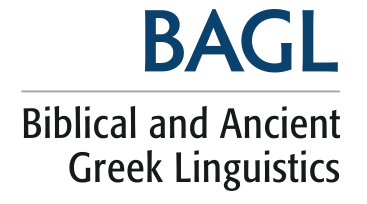1.1 | Wally V. Cirafesi McMaster Divinity College, Hamilton, ON, Canada This article argues that the construction ἔχειν πίστιν in
Hellenistic Greek is a nominalized ideational metaphor that is semantically related
to the finite verb πιστεύειν. Therefore, when the construction possesses
a genitive modifier, the function of the genitive is disambiguated as denoting the
object of πίστιν. This understanding of ἔχειν πίστιν + the genitive has
significant implications for interpreting the construction in Mark 11:22, Jas 2:1,
and Hippolytus‘s De Antichristo 61:26. (Article) Keywords: πίστιϛ Χριστοῦ, Greek linguistics, nominalization, grammatical
metaphor, Mark 11:22, Jas 2:1, Hippolytus |
1.2 | Gregory P. Fewster McMaster Divinity College, Hamilton, ON, Canada Adapting Michael Hoey‘s lexical priming theory, this article provides a new
rubric for the evaluation of intertextuality in the New Testament. This article
tests the veracity of the claim that the lexeme ματαιότηϛ functions to
invoke the language of Ecclesiastes. Romans 8 mirrors some of the language of
Ecclesiastes, while Eph 4:17 has strong ties to Rom 8, creating an intertextual
chain via the lexeme ματαιότηϛ. (Article) Keywords: ματαιότηϛ, intertextuality, priming, Romans 8, 2 Peter 2, Ephesians
3 |
1.3 | Hughson Ong McMaster Divinity College, Hamilton, ON, Canada This article relates to the criteria of language authenticity in historical
Jesus research and inquires into the lingua franca of Je- sus’ social environment.
It demonstrates via sociolinguistic principles that Palestine was a multilingual
society, establishes that various so- cial groups necessitate the use of language
varieties, and addresses the issue of language choice—the occasions and reasons
multilingual people use their native tongue over and against their second language.
The objective is to show in four “I have come” sayings in the Synop- tics that, with
high probability, Jesus’ internal language was Aramaic, and his public language was
Greek. Keywords: Historical Jesus, Greek language, sociolinguistics, Mark 2:17, Mark 10:45,
Luke 12:49–51, Matt 5:17 |
1.4 | Steven E. Runge Logos Bible Software | Stellenbosh University, Stellenbosch, South
Africa This study applies the cognitive model of Chafe and Givón, and the
information-structure model of Lambrecht as applied by Levinsohn and Runge to the
Markan explanation of the Parable of the Sower (4:14–20). The primary objective is
to identify and analyze other linguistic devices, besides demonstratives, which
might clarify the apparent prominence given to the unfruitful scatterings in Mark’s
account. This study provides the necessary framework for comparing Mark’s pragmatic
weighting of saliency to that found in Matthew and Luke’s accounts in order to
determine whether Mark’s version is con-sistent with or divergent from the other
traditions. Keywords: saliency, information structure, Mark 4:14–20, Matt 13:19–23, Luke 8:11–15,
οὗτος, ἐκεῖνος |

